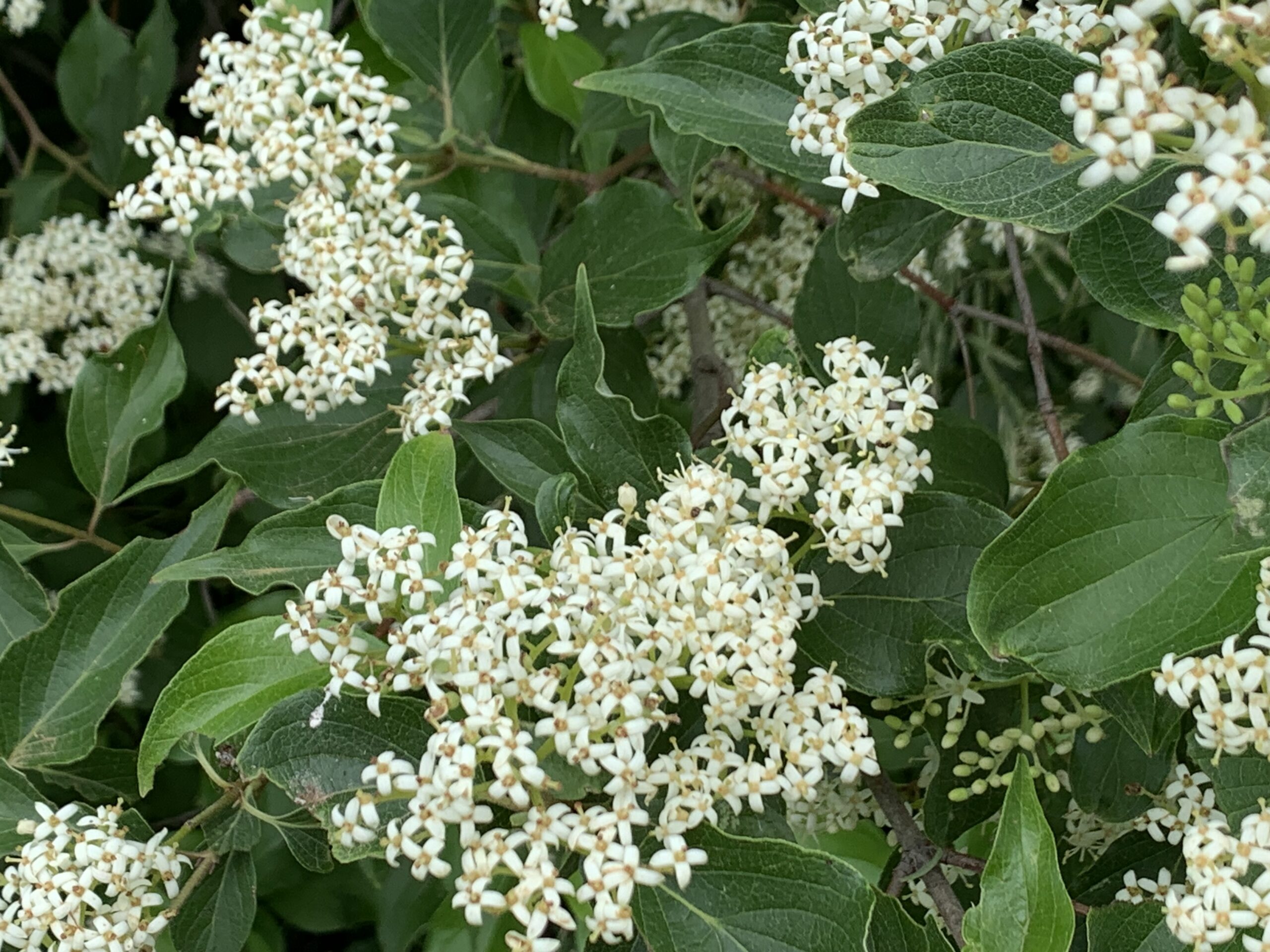Last fall we identified several types of berries along the edges of Owl Acres. One type of those berries was the white, pea-sized berries of the rough-leaf dogwoods which were growing in the yard and along the railroad tracks. I was familiar with some of the legends surrounding the dogwood, and was perhaps a bit disappointed to learn that they didn’t pertain to our dogwoods.
The rough-leaf dogwood (Cornus drummondii) is a fast-growing tree or shrub. It will grow up to 25 feet, but also grows like a tall shrub with multiple trunks. Dogwoods make a nice hedge or windbreak when they’re planted in a row. They’ve also been planted to help control erosion.
The rough-leaf dogwood is one of six native species of dogwoods found in Iowa. It is characterized by a sandpapery roughness on the upper side of the leaves and a wooly texture on the underside. The flowering dogwoods of legend don’t grow in Iowa.
Two explanations of how the dogwood got its name are floating around cyberspace. One says that the hard, dense wood of the tree was split into sticks for skewering meat. The sticks were called “dogs,” and the tree was thus named for them. The second legend is that in England, the wood or bark of the dogwood was powdered and used to bathe dogs to get rid of mange.
Actually, parts of the dogwood were said to be used by pioneers and native Americans for antibiotic and astringent properties, and today dogwood is being studied as an antibiotic additive in animal feed. Its antimicrobial properties are also under study. So maybe the mange story isn’t so far off?
The dogwood has captured the imaginations of generations, creating a rich collection of legends and lore. When I was living on the East Coast, I heard another legend about the dogwood. It is based on the fact that the flowering dogwoods bloom around Eastertime. The flowers are white and have four petals, two long, two shorter, with rusty dots on them. The flower was likened to a cross, and the dots were said to represent rusty nails. Another legend has to do with the dogwood being Adam’s favorite tree in the Garden of Eden, and the Devil climbing the wall on a locust tree to destroy all the dogwoods.
Yet another legend says that the Cross was made of dogwood. Dogwood isn’t native to Jerusalem, but the symbolism is cherished by some.
The dogwoods we have on Owl Acres aren’t the kind that actually have those famed fragrant, cross-shaped blossoms. Their flowers are white and four-petaled, blooming in clusters, but much smaller, and their bloom time is May to June–well after Easter here on Owl Acres. This is just okay with at least 18 different species of insects like aphids, beetles, bees, flies, leafhoppers, weevils, bees and wasps that inhabit these native plants. At least a dozen native moths and butterflies lay their eggs on dogwood leaves so that their caterpillars will have a ready buffet when they hatch. One particular species likes to roll the leaves up into a loose shelter before eating them.
The dogwood has a woody, branching taproot. If it is damaged, it will send up shoots that eventually create a whole thicket of trunks and stems. Otherwise it grows with one trunk like a tree.

Clusters of white berries of Roughleaf Dogwood in the fall. The foliage is tired and raggedy after a summer of hard work. Author photo.
In the fall, our dogwoods produce white berries. They aren’t poisonous, but they are not really edible except by the birds. They taste bitter and full of tannins, and I quickly spit out the one I was testing. Speaking of the birds, the berries are quite high in calories and make good winter food for all the songbirds that live on Owl Acres. White-footed mice, squirrels, and chipmunks also eat the berries. Deer like to browse on the leaves, too. So our native rough-leaf dogwood provides a banquet for our native fauna in a partnership that has been forged over thousands of years. We may not have created legends around them, but they hold their own on Owl Acres.
Feature photo by Author. Alt text: Dense clusters of tiny white flowers with yellow centers amid verdant, springtime foliage of Roughleaf Dogwood.
